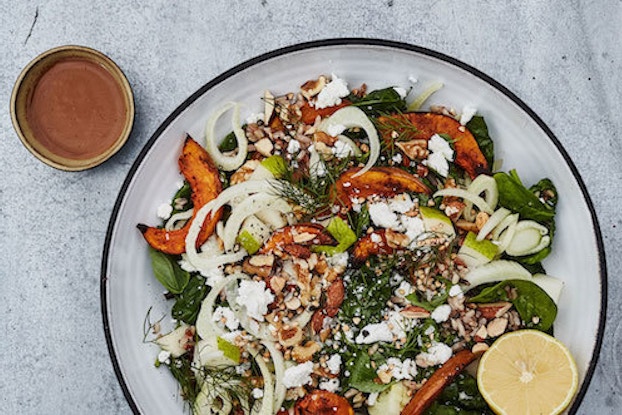
Every decision the healthy, fast-casual restaurant chain Sweetgreen makes is about connecting communities to sustainably grown food that tastes delicious and is good for you, too, said Kevin Quandt, vice president of supply chain and sustainability in a keynote presentation at the FoodInno 2019 food innovation conference at Stanford University in May.
“Sustainability permeates the company. We operationalize sustainability throughout the entire supply chain,” Quandt told CO— in an interview following his keynote presentation at the conference. “But it’s not as simple as that,” he added. “Taste and sustainability go hand-in-hand at Sweetgreen. We’re about offering clean, sustainably grown, healthy food with transparent ingredients that tastes delicious. That’s the magic of Sweetgreen.”
Its mission to offer a customer experience around tasty, sustainably grown, healthy food is what’s helping drive growth at Sweetgreen while differentiating it from the competition, according to Quandt.
Privately held Sweetgreen, which was founded in 2007 by three 20-something Georgetown University graduates, today operates 96 locations in eight states. It counts AOL founder Steve Case, sports and entertainment mogul Ted Leonis and Fidelity Investments among its investors, and is currently valued at an estimated $1 billion.
Farm-to-restaurant
Sweetgreen’s ongoing and growing commitment to buying as much produce and other ingredients as possible directly from smaller farmers and purveyors who use sustainable practices is integral to its market positioning, Quandt said. The healthy, fast-casual restaurant chain calls its vendors sourcing partners because Quandt and his team work directly with them as partners to ensure the products they produce meet Sweetgreen’s sustainability and taste specifications.
For example, Sweetgreen sources organic romaine and broccoli leaf lettuce directly from Full Belly Farm, which is based in Capay Valley, California; fresh berries and three varieties of squash from Ward’s Berry Farm in Sharan, Massachusetts; and Columbia river Steelhead from Pacific Seafood in Nespelem, Washington, according to Quandt, who said these and other sourcing partners are chosen because they put the utmost focus on the sustainable production of top-quality food.
Be Competitive
Sweetgreen is constantly evolving in the face of tough competition. Learn how to assess your competitors' strengths and weaknesses.
Sweetgreen is a platform at the intersection of tech and food. We’re going to sell more things than salad through digitalization.Kevin Quandt, VP, Sweetgreen
Seed-to-restaurant
Sweetgreen has kicked its farm-to-restaurant initiative up in a major way with a new partnership with noted chef and author Dan Barber, who’s known for sustainability. Sweetgreen’s unique seed-to-restaurant initiative, launched in late 2018, involves breeding vegetables for flavor using sustainable farming practices, Quandt said.
The chain enlisted Barber and his company Row 7, a startup the chef and his partners call a seed company that's also dedicated to producing tasty, sustainable food, to create an ultra-flavorful variety of squash called Robin’s Koginut. The new variety of organically grown squash combines the rich flavor of butternut with the smooth, dry texture of Japan’s kabocha variety, Quandt said.
“Breeding and sustainably producing new varieties of produce for taste in partnership with a great chef like Dan Barber is one of the ways we’re differentiating Sweetgreen from the competition,” he said in describing the seed-to-table initiative.
Sweetgreen is working with chef Barber on creating other new crop varieties as part of this initiative, which also taps into ingredient transparency, according to Quandt. “We believe eaters increasingly want clean food with transparent ingredients that is sustainably grown and tastes delicious,” he added. “Consumers are willing to pay a little more for real food.”
Indeed, “rather than leading with only sustainability benefits, Sweetgreen is also centered on flavor, which helps make sustainability popular and even sexy,” said Daniele Gould, founder and co-CEO, respectively, of food innovation platforms Food + Tech Connect and Alpha Food Labs.

Digitizing sustainability and deliciousness
Even given Sweetgreen’s fastidious devotion to that niche, it’s gaining competitors in the healthy, fast-casual restaurant space, including fast-growing brick-and-mortar chains like Chopt, Just Salad and Salata.
Quandt acknowledges the competition and noted Sweetgreen isn’t standing still.
“Sweetgreen isn’t just a salad chain that offers healthy, sustainably grown food that tastes good,” Quandt said. “Sweetgreen is a platform at the intersection of tech and food. We’re going to sell more things than salad through digitalization.”
Sweetgreen made its first move in this direction with its acquisition of Washington, D.C.-based meal delivery service Galley Foods on June 11, 2019.
The acquisition, Sweetgreen’s first, gives it the ability to offer its popular, sustainably grown, healthy foods via digital ordering and home delivery. It also allows Galley Foods to leverage Sweetgreen’s sustainable food supply chain, according to a statement from the fast-casual chain.
“An increased focus on digitalization fits perfectly with Sweetgreen’s mission and commitment to inspire healthier communities by connecting people to real food that’s sustainably produced and tastes delicious, along with meeting consumers wherever they are,” Quandt said.
Digitalization also allows Sweetgreen to extend its consumer experience beyond brick and mortar, which Quandt said is a natural progression for the healthy, fast-casual restaurant chain.
CO— aims to bring you inspiration from leading respected experts. However, before making any business decision, you should consult a professional who can advise you based on your individual situation.
CO—is committed to helping you start, run and grow your small business. Learn more about the benefits of small business membership in the U.S. Chamber of Commerce, here.







